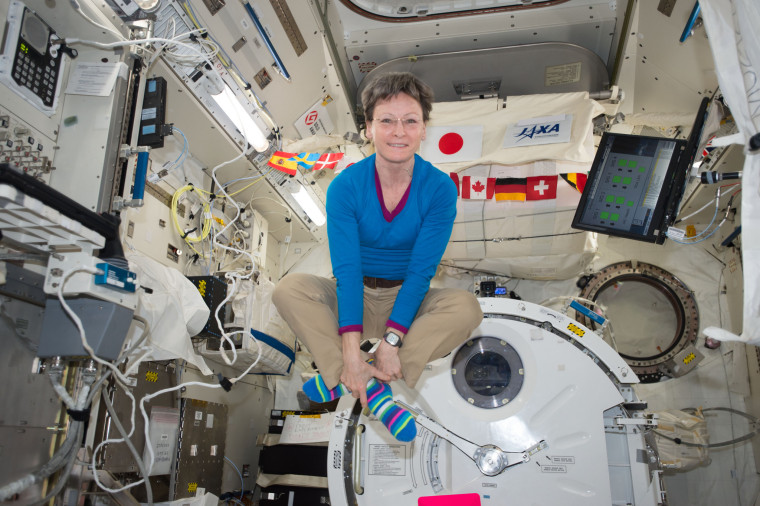Peggy Whitson's job demands a daily two-hour workout in a gym where weight has no meaning, members can grow taller and the view changes at 17,000 miles an hour.
Whitson makes it look easy. At 57, she is the oldest woman to fly in space, breaking the record last November when she began her third long-term stay at the International Space Station.
After returning home in September, the NASA astronaut is matter-of-fact about the age milestone.
“It wasn’t a record I was seeking out,” Whitson told TODAY. “I don’t think people should let age discourage them, even on those jobs that require some amount of physical fitness, like the astronaut job. You can work and train your body to do way more than you might ever imagine.”
On Earth, the Iowa-native stays fit by weightlifting, biking, playing basketball and water skiing. She shared what it's like to push herself to do something out of this world:
On being the oldest woman in space:
The more people we have flying, the more you’re going to have older people going into space. The oldest man is John Glenn (at 77), but we’ve had male astronauts in their 60s before, so it’s not that unusual to be in your late 50s and be able to fly in space. It was just a matter of time before women started flying in space at this age.
I was 42 and 48 for my first two space flights. I feel lucky that I was able to get to do another one in my 50s. You can still be successful and do physical things when you get older.
Exercising in microgravity:
Each day, we have about two hours allocated to exercise (to prevent muscle and bone loss). Anybody who wants to be healthy when they come back home is going to do it.
A little over an hour is spent on the resistive exercises — we use a device that’s like weight lifting. Obviously, weight doesn’t have any meaning up there, so we pull against a resistance. The new device works phenomenally well — it really does feel like you’re lifting weights like on the ground.
We also do an hour of cardiovascular exercise. There’s a treadmill — the catch with that you have to have a harness on (to keep from floating away), so you have a lot of pressure on your shoulders and hips while you run. I didn’t end up doing a lot of running, but it was important to do just to remember how to walk. We also have a bicycle ergometer. That’s what I used for cardiovascular fitness.
In space, you actually grow an inch or so because your spinal column expands out without gravity.
Diet in space:

We’ve gotten much more health-conscious in the foods that are supplied to the station. Obviously, they have to be dehydrated or preserved. The biggest change has been the reduction in salt — salt was used as a preservative a lot initially and also because your taste gets dulled when you’re in orbit, so salt makes the food taste a little better. But that was negatively impacting bone density.
I always tell the new guys coming up: “It’s all about the sauce.” Because without the salt, you tend to need more sauce to make things spicy or to give them a little more flavor. Cargo vehicles come up every month or two and we might get fresh apples or oranges, and some cheeses.
We monitor the calories because in general, we’re afraid people are going to lose weight, and people who tend to lose the most weight also tend to lose the most bone mass. On this last mission, we had a new app on board that made it easy to keep track of what we were eating. It’s pretty equivalent to the amount of calories I’d eat on Earth.
Life in microgravity:
It’s like you’re in a swimming pool, but you don’t have to worry about breathing. If I push off from one side, I’m going to float to the other side. Every orientation feels exactly the same, which is really hard for your brain to grasp, but it’s amazing how fast you adapt.
It’s a big shock for the body to come back to Earth — everything is so heavy. We spend a lot of time getting used being back in gravity again. It’s not so much strength — it’s more about agility and balance. Back pain was really the most dramatic for me this time. For me, coming home is way harder than going up into space.
On being an introvert:
I actually think being a little introverted makes it easier to be on the International Space Station. You’re working with fewer people. It gets a little boring for some of those extroverted types who like more social interaction.
Watching Earth from above:
Your perspective on life and what our planet is can’t be completely unchanged by the experience of being in space and seeing our planet from that vantage point. We’re all one. We’re all on board the same ship called planet Earth and we need to take care of her.